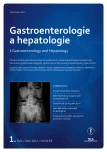Cytomegaloviral colitis in organ transplant recipients
Authors:
D. Kamenář; P. Drastich
; H. Gottfriedová; J. Malušková; J. Šperl
; P. Štirand; P. Trunečka; J. Špičák
Authors‘ workplace:
Institut klinické a experimentální medicíny IKEM
Published in:
Gastroent Hepatol 2011; 65(1): 26-29
Category:
Clinical and Experimental Gastroenterology: Original Article
Overview
Purpose of the study:
A cytomegaloviral infection causes significant morbidity in organ transplant recipients. The most frequent type of impairment of immunosuppressed patients is CMV colitis. The definitive diagnosis of CMV colitis requires the immunohistochemical examination of tissue from affected parts of the colon. It is our aim to describe our experiences with such patients in our institute and evaluate the diagnostic and therapeutic options for CMV colitis.
Methods:
A total of 20 patients were identified in the electronic database of the Institute for Clinical and Experimental Medicine who had undergone organ transplantation and been hospitalised in IKEM with immunohistochemically confirmed CMV colitis in the period from January 2001 to December 2008. A retrospective evaluation was then made of the relevant data for these patients.
Results:
The group of 20 patients consisted of 8 men and 12 women with an average age of ±57.4 years, standard deviation 6.1 years, range 40–67 years. 12 patients had undergone a kidney transplantation, 5 a liver transplantation and 3 a heart transplantation. The average interval between the transplantation and endoscopic examination was 38.1 months (in the range 1–140 months, median 7 months). All patients were treated with immunosuppressants – corticoids and/or various combinations of mycophenolate mofetil, cyclosporine, tacrolimus or sirolimus. 15 patients showed acute diarrhoea, 3 patients had chronic diarrhoea, one patient presented with isolated hematochezia and the other with abdominal pain only. Four of nine patients who were evaluated were found to be positive for anti-CMV-IgM. All 20 patients were tested for the presence of an early CMV antigen or CMV DNA using the blood PCR method, with 11 positive cases. Endoscopic tests showed 4 types of impairment: erythema and edema (eleven patients), multiple isolated ulcers (2 patients), erythema and edema together with ulcers (5 patients) and the image of pseudomembanous colitis (2 patients). Histological examinations of lesions showed normal inflammatory changes with dominating mononuclear cellulisation. 13 patients showed typical inclusions. All 20 patients with CMV colitis were treated with glanciclovir and/or valganciclovir. 19 patients survived, one patient died from causes unrelated to CMV colitis.
Conclusion:
The diagnosis of CMV colitis in the recipients of organ transplants relies on an active diagnostic approach, including total colonoscopy, with biopsies of affected sections of the colon and their histological and immunohistochemical examination. This strategy provides early and definitive diagnosis and allows specific therapy of CMV colitis with highly effective antiviral agents in a timely manner.
Key words:
cytomegalovirus – colitis – ganciclovir – immunosuppresants – organ transplantation – valganciclovir
Sources
1. Baroco AL, Oldfield EC. Gastrointestinal cytomegalovirus disease in the immunocompromised patient. Curr Gastroenterol Rep 2008; 10(4): 409–416.
2. Korkmaz M, Kunefeci G, Selcuk H et al. The role of early colonoscopy in CMV colitis of transplant recipients. Transplant Proc 2005; 37 : 3059–3060.
3. Bobak DA. Gastrointestinal Infections Caused by Cytomegalovirus. Curr Infect Dis Rep 2003; 5(2): 101–107.
4. Rubin RH. The pathogenesis and clinical management of cytomegalovirus infection in the organ transplant recipient: the end of the ‚silo hypothesis‘. Curr Opin Infect Dis 2007; 20(4): 399–407.
5. Paya CV, Razonable RR. Cytomegalovirus infection after Solid organ transplantation. In Transplant Infectious Diseases, edn 2. Edited by Bowden RA, Ljungman P, Paya CV. Philadelphia: Lippincott Williams & Wilkins; 2003 : 298–325.
6. Arthurs SK, Eid AJ, Pederson RA et al. Delayed-onset primary cytomegalovirus disease and the risk of allograft failure and mortality after kidney transplantation. Clin Infect Dis 2008, 46(6): 840–846.
7. Ljungeman P, Griffiths P, Paya C. Definitions of cytomegalovirus infection and disease in transplant recipients. Clin Infect Dis 2002; 34(8): 1094–1097.
8. Olofinlade O, Chiang C. Cytomegalovirus infection as a cause of pseudomembrane colitis: a report of four cases. J Clin Gastroenterol 2001; 32(1): 82–84.
9. Torres HA, Kontoyiannis DP, Bodey GP et al. Gastrointestinal cytomegalovirus disease in patients with cancer: a two decade experience in a tertiary care cancer center. Eur J Cancer 2005; 41(15): 2268–2279.
10. Toogood GJ, Gillespie PH, Gujral S et al. Cytomegalovirus infection and colonic perforation in renal transplant patients. Transpl Int 1996; 9(3): 248–251.
11. Paya CV, Hermans PE, Smith TF et al. Efficacy of ganciclovir in liver and kidney transplant recipients with severe cytomegalovirus infection. Transplantation 1988; 46(2): 229–234.
12. Len O, Gavaldá J, Aguado JM et al. Valganciclovir as treatment for cytomegalovirus disease in solid organ transplant recipients. Clin Infect Dis 2008; 46(1): 20–27.
13. Asberg A, Humar A, Rollag H et al. Oral valganciclovir is noninferior to intravenous ganciclovir for the treatment of cytomegalovirus disease in solid organ transplant recipients. Am J Transplant 2007; 7(9): 2106–2113.
14. Khoury JA, Storch GA, Bohl DL et al. Prophylactic versus preemptive oral valganciclovir for the management of cytomegalovirus infection in adult renal transplant recipients. Am J Transplant 2006; 6(9): 2134–2143.
15. Kliem V, Fricke L, Wollbrink T et al. Improvement in long-term renal graft survival due to CMV prophylaxis with oral ganciclovir: Results of a randomized clinical trial. Am J Transplant 2008; 8(5): 975–983.
16. Luan FL, Stuckey LJ, Park JM et al. Six-month prophylaxis is cost effective in transplant patients at high risk for cytomegalovirus infection. J Am Soc Nephrol 2009; 20(11): 2449–2458.
Labels
Paediatric gastroenterology Gastroenterology and hepatology SurgeryArticle was published in
Gastroenterology and Hepatology

2011 Issue 1
- Metamizole at a Glance and in Practice – Effective Non-Opioid Analgesic for All Ages
- Spasmolytic Effect of Metamizole
- Metamizole vs. Tramadol in Postoperative Analgesia
- The Importance of Limosilactobacillus reuteri in Administration to Diabetics with Gingivitis
Most read in this issue
- Cytomegaloviral colitis in organ transplant recipients
- Is it possible to reintroduce original biological therapy in a relapsed Crohn’s disease patient?
- Acute mesenteric ischemia
- Autoimmune form of chronic pancreatitis and IgG4 positive mastitis
